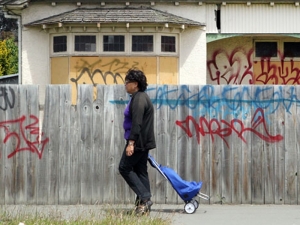 |
| Tagging in Christchurch costs the city thousands of dollars each year. |
Police have nabbed a teenager they say is one of Christchurch's (New Zealand) most
prolific taggers, as part of a new hardline approach to the vandalism.
Senior Sergeant Glenn Nalder said an 18-year-old was arrested last
week and charged with wilful damage for allegedly causing "several
thousands of dollars" worth of graffiti damage in Woolston, Linwood and
Richmond - most notably on Stanmore Rd.
Nalder said the teenager was identified using a list provided by the
Christchurch City Council as one of the five "most prolific" taggers in
the city.
A new list is compiled each month as part of the council's new tagforce programme, he said.
Under an initiative set up a few months ago, council staff map
complaints to its graffiti hotline and collate photos of the tags.
"We've had a pretty good strike rate. In any given month we're
confident we can [arrest] two or three of them [and] in the past we
would only charge them with one or two tags," Nalder said.
The 18-year-old has appeared before the courts and will do so again on December 6.
In other significant arrests using the council's database, a
14-year-old and 15-year-old were arrested last month for allegedly
causing damage into the "tens of thousands of dollars" each, Nalder
said.
Both were charged with etching bus windows and tagging, predominantly in the eastern suburbs.
"One tag is annoying, but when you're doing a dozen or hundreds of
tags, the cost to the community adds up pretty quick. It's similar
offending to stealing a luxury car or 10 burglaries," Nalder said.
The hardline approach will come as welcome relief to fed-up residents in the city's east.
City council figures show reports to its graffiti hotline have soared in recent months.
The number of complaints usually fluctuates from 550 to 750 a month, but in October that figure reached 1066.
Nalder said that increase could be driven by more public awareness and the absence of property owners.
"We're going through a phase where they [tags] are not being cleaned off as quickly as in the past," he said.
New Brighton resident Sue Davidson said tagging was "like a dog lifting its leg and marking its territory".
She helped organise a month of "mural madness" during November to give the area a point of difference.
The drive also prevented tagging because none of the murals had been vandalised, she said.
University of Canterbury student Reuben Woods, who is working on a
thesis about the city's post-quake street art, said that although some
tagging was "kids out there trying to cause havoc", it could also
reflect a sense of abandonment.
"It is indicative of the state of the east side," he said.
Source: TVNZ
Comments